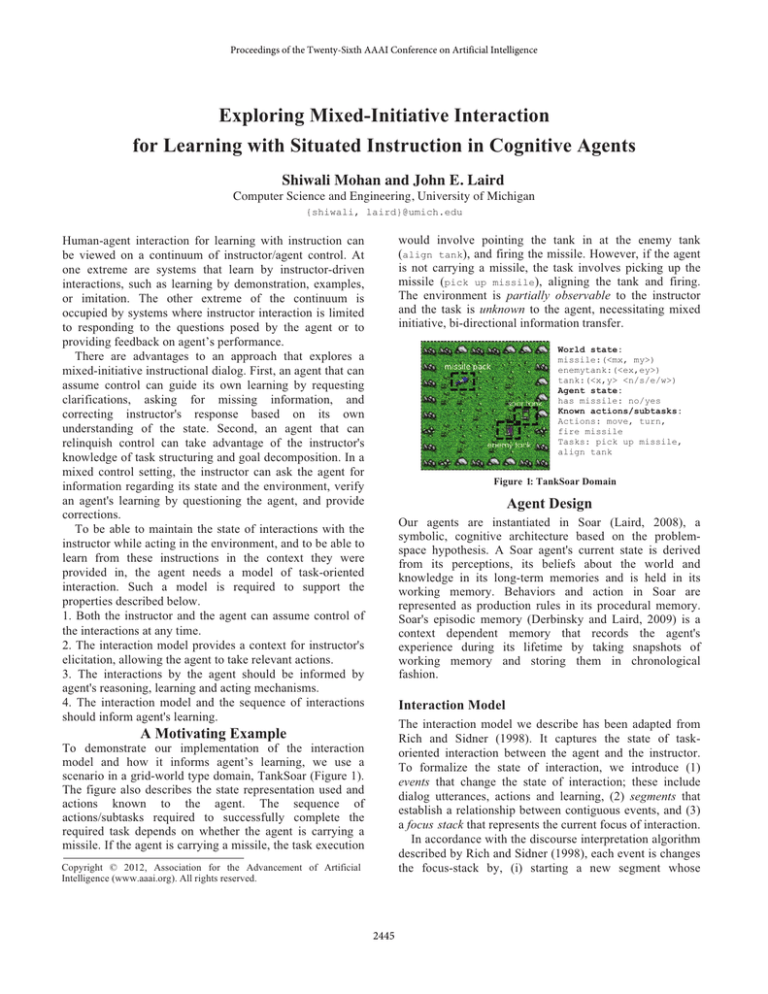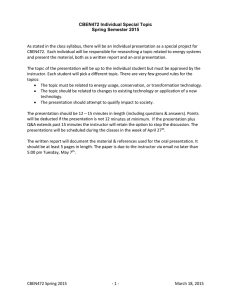
Proceedings of the Twenty-Sixth AAAI Conference on Artificial Intelligence
Exploring Mixed-Initiative Interaction
for Learning with Situated Instruction in Cognitive Agents
Shiwali Mohan and John E. Laird
Computer Science and Engineering, University of Michigan
{shiwali, laird}@umich.edu
would involve pointing the tank in at the enemy tank
(align tank), and firing the missile. However, if the agent
is not carrying a missile, the task involves picking up the
missile (pick up missile), aligning the tank and firing.
The environment is partially observable to the instructor
and the task is unknown to the agent, necessitating mixed
initiative, bi-directional information transfer.
Human-agent interaction for learning with instruction can
be viewed on a continuum of instructor/agent control. At
one extreme are systems that learn by instructor-driven
interactions, such as learning by demonstration, examples,
or imitation. The other extreme of the continuum is
occupied by systems where instructor interaction is limited
to responding to the questions posed by the agent or to
providing feedback on agent’s performance.
There are advantages to an approach that explores a
mixed-initiative instructional dialog. First, an agent that can
assume control can guide its own learning by requesting
clarifications, asking for missing information, and
correcting instructor's response based on its own
understanding of the state. Second, an agent that can
relinquish control can take advantage of the instructor's
knowledge of task structuring and goal decomposition. In a
mixed control setting, the instructor can ask the agent for
information regarding its state and the environment, verify
an agent's learning by questioning the agent, and provide
corrections.
To be able to maintain the state of interactions with the
instructor while acting in the environment, and to be able to
learn from these instructions in the context they were
provided in, the agent needs a model of task-oriented
interaction. Such a model is required to support the
properties described below.
1. Both the instructor and the agent can assume control of
the interactions at any time.
2. The interaction model provides a context for instructor's
elicitation, allowing the agent to take relevant actions.
3. The interactions by the agent should be informed by
agent's reasoning, learning and acting mechanisms.
4. The interaction model and the sequence of interactions
should inform agent's learning.
World state:
missile:(<mx, my>)
enemytank:(<ex,ey>)
tank:(<x,y> <n/s/e/w>)
Agent state:
has missile: no/yes
Known actions/subtasks:
Actions: move, turn,
fire missile
Tasks: pick up missile,
align tank
Figure 1: TankSoar Domain
Agent Design
Our agents are instantiated in Soar (Laird, 2008), a
symbolic, cognitive architecture based on the problemspace hypothesis. A Soar agent's current state is derived
from its perceptions, its beliefs about the world and
knowledge in its long-term memories and is held in its
working memory. Behaviors and action in Soar are
represented as production rules in its procedural memory.
Soar's episodic memory (Derbinsky and Laird, 2009) is a
context dependent memory that records the agent's
experience during its lifetime by taking snapshots of
working memory and storing them in chronological
fashion.
Interaction Model
The interaction model we describe has been adapted from
Rich and Sidner (1998). It captures the state of taskoriented interaction between the agent and the instructor.
To formalize the state of interaction, we introduce (1)
events that change the state of interaction; these include
dialog utterances, actions and learning, (2) segments that
establish a relationship between contiguous events, and (3)
a focus stack that represents the current focus of interaction.
In accordance with the discourse interpretation algorithm
described by Rich and Sidner (1998), each event is changes
the focus-stack by, (i) starting a new segment whose
A Motivating Example
To demonstrate our implementation of the interaction
model and how it informs agent’s learning, we use a
scenario in a grid-world type domain, TankSoar (Figure 1).
The figure also describes the state representation used and
actions known to the agent. The sequence of
actions/subtasks required to successfully complete the
required task depends on whether the agent is carrying a
missile. If the agent is carrying a missile, the task execution
Copyright © 2012, Association for the Advancement of Artificial
Intelligence (www.aaai.org). All rights reserved.
2445
applicable to not only the situations that the instructions
were provided in, but also in similar, analogous situations.
Huffman and Laird (1995) introduced general task learning
by situated explanation in which the agent internally
projects the effects of instruction starting from the state the
new task was first suggested. If the projection successfully
achieves the termination conditions of the new operator the
agent learns general task execution rules. In our
implementation, the episodic memory of the agent is
instrumental in reconstructing the state where the task was
first executed in, and the focus-stack is instrumental in
projecting the instructed actions in the correct context.
purpose contributes to the current purpose (and thus,
pushing a new segment with a related purpose on the focus
stack), (ii) continuing the current segment by contributing
to the current purpose, (iii) completing the current purpose
(and thus eventually popping the focus stack) or (iv)
starting a new segment whose purpose does not contribute
to the current purpose (and thus pushing a new, interrupting
segment on the focus-stack, changing the purpose of the
interaction). An event contributes to a segment, if (i) it
directly achieves the purpose, and (ii) it is a step in
achieving the purpose.
Applying the Interaction Model to TankSoar
Discussion
If the agent does not know which tasks can be executed in
the environment, it initiates an interaction with the
instructor by pushing a segment (s1) on the focus-stack.
The purpose of this segment is to acquire the next task to
undertake. The instructor replies with a task, attack-tank.
The purpose of segment (s1) is achieved, and it is removed
from the focus stack. A new segment (s2) is introduced,
whose purpose is for the agent to execute the task in the
environment.
To execute it, the agent proposes an operator
corresponding to the task. However, since the agent is
executing this task the first time, it does not know how to
proceed further. An impasse occurs, which causes the agent
to introduce another segment (s3) on the focus stack with a
purpose to get an example execution of the task. The agent
then initiates a segment (s4) to prompt the instructor for a
next action to execute. The selection of next action depends
on if the agent is carrying a missile. However, the instructor
cannot observe what the agent’s state it. If the interaction
was constrained to be agent-initiated only, the instructor
would be forced to take an uninformed guess. In case the
instructor suggests an action that is not available to the
agent, it would not be able to progress in the task.
In mixed-initiative interaction settings, the instructor
initiates a segment (s5) with a purpose to get more
information about the state of the agent.
Segment (s5) interrupts the current purpose of interaction
by introducing a momentary distraction. The agent replies
with information about its state, and removes segment (s5)
from the focus-stack, reverting the status of interaction to
what it was earlier. The agent continues to prompt the
instructor for next action until the instructor indicates that
the agent has successfully completed the task. Segment (s3)
is removed from the focus-stack. The agent, then, initiates a
segment (s6) whose purpose is to inquire about the goal of
the task. The instructor replies with the goal predicates,
which achieves the purpose of the agent-initiated segment
(s6). The agent performs situated explanation through
introspective recall, and on arriving at successful
explanation removes (s1).
Previous work on mixed-initiative instructional learning has
assumed that the instructor can completely observe the
environment, and therefore, limit the interactions initiated
by the instructor (Huffman and Laird 1995); has focused on
learning by demonstration (Allen et al. 2007) or has
concentrated on acquiring task specification knowledge for
non-situated knowledge-bases (Boicu et al. 2001). We are
interested in learning task execution knowledge situated in
agent’s experience in the environment and aided by mixedinitiative, bi-directional transfer of information between the
agent and the instructor.
In our representation of the interaction state, initiative
can be defined in terms of the ability of a participant to
introduce segments on the focus stack. Events from both
the instructor and the agent cause modifications in the
stack, allowing both to introduce segments with specific
purposes in the interaction (requirement 1). The focus-stack
provide context to instructor elicitation (requirement 2) and
allows the agent to progress in the environment. Agentinitiation depends on it detecting its incapability to progress
further in the task, signified by an impasse (requirement 3).
The focus-stack also facilitates in retrieving the correct
episode from episodic memory (requirement 4), allowing
the agent to learn generalized task application knowledge.
There are several avenues for further exploration and
study. An agent operating in a novel environment is
required to not only acquire task-application knowledge,
but also to learn recognition and semantic categorization of
new objects, spatial relationships between objects and
hierarchical task decomposition. We are interested in
exploring if the interaction model described here can be
used effectively in these learning scenarios
References
Allen, J.; Chambers, N.; Ferguson, G.; and Galescu, L. 2007. Plow: A
Collaborative Task Learning Agent. In Proceedings of AAAI.
Boicu, M., Tecuci, G., and Stanescu, B. 2001. Mixed-Initiative Agent
Teaching and Learning, In Proceedings of ICAI.
Derbinsky, N., and Laird, J. 2009. Efficiently Implementing Episodic
Memory. In Proceedings of the 8th ICCBR.
Huffman, S. B., and Laird, J. E. 1995. Flexibly Instructable Agents. JAIR.
Laird, J. 2008. Extending the Soar Cognitive Architecture. In AGI.
Rich, C., and Sidner, C. 1998. COLLAGEN: A Collaboration Manager for
Software Interface Agents. User Modeling and User- Adapted Interaction.
Situated Instructional Learning
The goal of learning with human instruction to be able to
acquire general task execution knowledge, such that it is
2446

